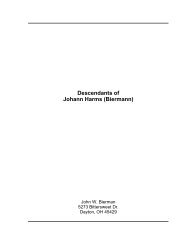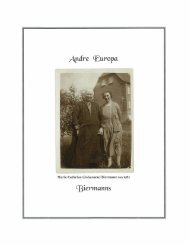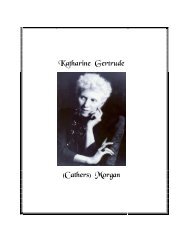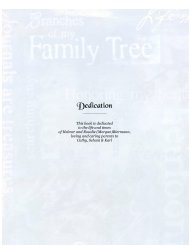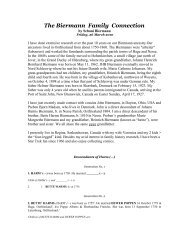A Collection of Dad's Essay's & Writings - Welcome
A Collection of Dad's Essay's & Writings - Welcome
A Collection of Dad's Essay's & Writings - Welcome
You also want an ePaper? Increase the reach of your titles
YUMPU automatically turns print PDFs into web optimized ePapers that Google loves.
- From Elijah to Hope -<br />
A History <strong>of</strong> Hope Lutheran Church<br />
<strong>of</strong> Saint John, NB<br />
uring the years 1930 and 1931 there were discussions by members <strong>of</strong> the Danish community in the city<br />
<strong>of</strong> Saint John concerning the feasibility <strong>of</strong> establishing a Lutheran church to serve those new<br />
immigrants from Denmark. A number <strong>of</strong> families, as well as individuals, had arrived in the area<br />
between 1920 and 1930 and thought it would be an excellent idea to hold services in the Danish<br />
language for these new immigrants. There was a distinct possibility that more Danes would be arriving<br />
despite the difficulties encountered after the stock market crash <strong>of</strong> 1929 and Depression that ensued.<br />
In a field at the Jens Jensen property on Sandy Point Road in the late summer a number <strong>of</strong> these Danes decided<br />
that a congregation should be established and the first service in Danish would be held later in the fall. Rev. Ravnkilde<br />
Moller, a student pastor living in New Denmark, arrived and was appointed pastor <strong>of</strong> the parish, evidently with<br />
assistance and the blessings <strong>of</strong> the Bishop <strong>of</strong> Copenhagen. The Bishop <strong>of</strong> Copenhagen was the head <strong>of</strong> the church,<br />
known originally as Elijah Danish Lutheran Church. It is possible that some assistance was obtained from DKU<br />
(Dansk Kirke i Udlandet--Danish Church Abroad). In 1931 there was not a great deal <strong>of</strong> employment available and<br />
weekly salaries were very small. One member <strong>of</strong> the congregation at the time remarked that the total weekly salary <strong>of</strong><br />
its members totaled almost fifty dollars. The building used for the services was the former Zion Methodist Church,<br />
located at the head <strong>of</strong> Wall Street where Rockland Road and Burpee Avenue meet. The minister <strong>of</strong> the church was a<br />
gentle, kindly short man by the name <strong>of</strong> Lawson who assisted in obtaining the building for use. The first service in the<br />
Danish language was held in October <strong>of</strong> 1931 and the building was used until a parsonage, with a room for services,<br />
was acquired by Pastor Møller on Rockland Road, opposite Park Street. This building no longer exists. Many <strong>of</strong> the<br />
young Danish children were given instruction in a Sunday School. Among the teachers was Mrs. Carl Pedersen, who<br />
with husband and family had lived in Winnipeg before coming to Saint John in the early 1930’s. Mrs. Pedersen was<br />
the most dominant force in that church school and along with Mrs.Kristen (Viola) Skavn managed to impart stories<br />
from the Bible into a small but enthusiastic group <strong>of</strong> Danish children. The Sunday school classes were generally held<br />
on Sunday afternoon and later on Sunday morning. All the instruction was given in the Danish language. The Church<br />
services, using the shortened liturgy, were in Danish and eventually there was an English service on the third Sunday<br />
<strong>of</strong> the month. Eventually services in English and in Danish were <strong>of</strong>fered Sunday mornings, with one early and the<br />
second service at 11 a.m.<br />
During the time that services were held at the former Zion Methodist Church, Danish style gatherings were held<br />
at Christmas time and were established with the help <strong>of</strong> Viola Skavn, who organized dances around the Christmas tree<br />
for members <strong>of</strong> the congregation and their children. Small gifts were given to the children and on one occasion<br />
Heinrich Biermann made arrangements for Richard Truswell, an amateur magician, to entertain those present. There<br />
were always Danish baked goods prepared by the ladies and a good cup <strong>of</strong> c<strong>of</strong>fee for the adults and treats for the<br />
children.<br />
Among the early members <strong>of</strong> the first congregation were Lars Hansen and family, AP Ovesen & family, Heinrich<br />
Biermann and family, Andreas Jensen and family, Fritj<strong>of</strong> Nielsen, Axel Husted Christensen, Bonde, Vigo Sorensen<br />
and family, Ole and Sigrid Olsen and son Vagn, Erik Schmidt Harald and Gudrun Thomsen, Jens Jensen and family<br />
and the Mikaelsen family.<br />
Kjeld Deichmann and his fiancée, Erika, were married in the church with the whole congregation in attendance.<br />
There was an incident with the Deichmann truck after the service but a member <strong>of</strong> the parish, AP Ovesen, came to the<br />
rescue and drove the bridal pair to their home. The Deichmanns later became well-known potters in the Moss Glen<br />
area and later at Sussex, and their artistry was known in many parts <strong>of</strong> the world.<br />
The majority <strong>of</strong> the church members <strong>of</strong> the early 1930’s were young married couples and singles between the ages<br />
<strong>of</strong> 19 and 40. Among the first deaths in the congregation were two little girls, Freda and Mildred Agnes Thomsen, ages<br />
four and nine months. They were daughters <strong>of</strong> Harald and Gudrun (Davidsen) Thomsen. Gudrun Thomsen was sister<br />
to Kathrine Biermann and Sigrid Ovesen. They were buried in a cemetery at Westfield. The Thomsens had come to<br />
Canada in the very late 1920’s. First losses <strong>of</strong> adults in the church membership occurred when Carl Emil Colberg,<br />
Danish born streetcar conductor, died in the summer <strong>of</strong> 1949 and was buried from the church, with Pastor Peder<br />
Thorslev <strong>of</strong>ficiating. His widow, Ingeborg Colberg, died in 1940 and her funeral was held from the Church on Second<br />
Street, with Pastor Peder Thorslev <strong>of</strong>ficiating. On December 6, 1941, the day before the Pearl Harbour disaster, Børge<br />
Pedersen, son <strong>of</strong> Olga and Chris Pedersen was killed while riding his bicycle on Rothesay Avenue. The family held<br />
membership in the church. In the fall <strong>of</strong> 1944, Hr. Flensted, a former Copenhagen banker, who settled first in New<br />
Denmark and later came to Saint John to work as accountant for TP Larsen, was buried with funeral service<br />
conducted by Rev. Archie Morck. One member who was buried from the church was <strong>of</strong> royal blood.



